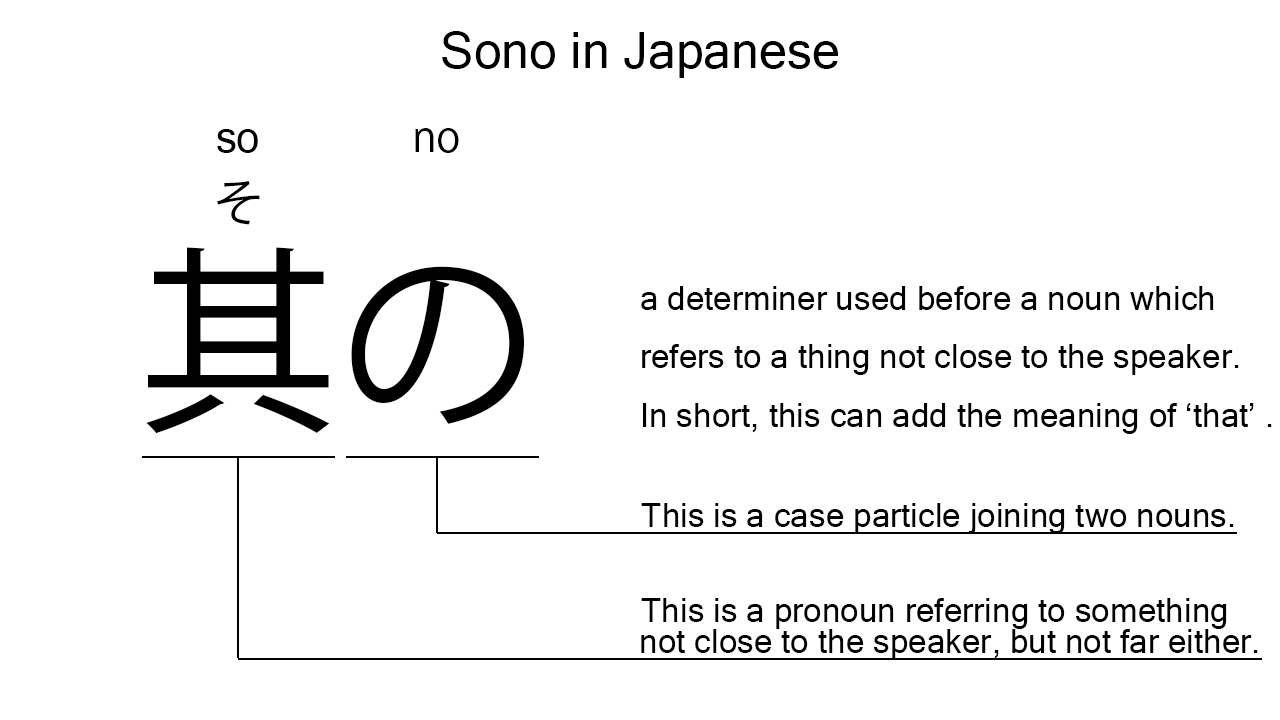What does “sono” mean in Japanese?
Native speakers often use “sono” as a determiner to add the meaning of ‘that’ in Japanese. Perhaps, some Japanese learners know this word as it is sometimes used in Japanese conversations. In this blog post, however, I will explain this word in detail together with its kanji expression. And also, I will explain how to use it through example sentences. My explanations would help Japanese learners understand “sono” more clearly. Then, let’s get started!
Contents
Definition and meaning of “sono”
Let me start with the definition and meaning of “sono”.
- sono – その : a determiner used in front of a noun which refers to something not close to the speaker, but not far either.
Japanese native speakers use this determiner in front of a noun to refer to something not close to them, but not far either. The role of this determiner is between those of “kono” and “ano“. It’s also worth mentioning here that native speakers use this in front of a noun to refer to something not close to them, but close to someone else like the listener.
This determiner is usually written in hiragana, but can be written in kanji too. Interestingly, its kanji expression helps us understand the concept more clearly, so let me explain it in detail.
Sono in kanji
The kanji expression of “sono” consists of the following two characters:
- 其 : a kanji character used as a pronoun to refer to something not close to the speaker, but not far either.
- の : a case particle joining two nouns or noun equivalent words. Normally, the first one can work as a modifier to describe the second. In this case, this works after “so” to change it to a modifier which means ‘that’ in Japanese.
These two characters tell us that the formed determiner literally means ‘that’ in Japanese. This literal interpretation is completely in line with the actual meaning and role.

So far, I’ve explained the definition and meaning of “sono” together with its kanji expression. Then, let me explain how to use it through the example sentences below.
Example #1: how to use “sono”
sono on’nanoko wa boku no imouto desu – その女の子は僕の妹です (そのおんなのこはぼくのいもうとです)
That girl is my little sister.
Below are the new words used in the example sentence.
- on’nanoko – 女の子 (おんなのこ) : a noun meaning ‘girl’ in Japanese. This can also work as plural. Learn more about Japanese plural.
- wa – は : a binding particle working as a case marker or topic marker. In the example, this works after “sono on’nanoko” to make the subject in the sentence.
- boku – 僕 (ぼく) : a pronoun meaning ‘I’ in Japanese. This is used mainly by boys and young males.
- no – の : a case particle used after a noun or pronoun to make its possessive case. In the example, this is used after “boku” to make its possessive case, “boku no”, which means ‘my’ in Japanese.
- imouto – 妹 (いもうと) : a noun meaning ‘little sister’ in Japanese. This can also work as plural.
- desu – です : an auxiliary verb used after a noun or adjective to make it polite. Probably, this is well known as a part of Japanese desu form. In the example, this is used after “boku no imouto” to make it sound polite.
This is a typical usage of “sono”. In this example, it works in front of “on’nanoko” to say “that girl” in Japanese.
Example #2: another usage of “sono”
watashi wa sono kuruma wo kat ta – 私はその車を買った (わたしはそのくるまをかった)
I bought that car.
Below are the new words used in the example sentence.
- watashi – 私 (わたし) : a pronoun meaning ‘I’ in Japanese.
- kuruma – 車 (くるま) : a noun meaning ‘car’ in Japanese. This can also work as plural.
- wo – を : a case particle used to make the object word in a sentence. In the example, this is used after “sono kuruma” to make the object in the sentence.
- kat – 買っ (かっ) : one conjugation of the verb, “kau“, which means ‘to buy’ in Japanese. In the example, it has been conjugated for the better connection with its following word.
- ta – た : an auxiliary verb used after a verb, adjective, or auxiliary verb to make its past tense form. In the example, this is used after “kat” to make its past tense form, “kat ta”.
This is another typical usage of “sono”. In this example, it works in front of the noun, “kuruma”, to say “that car” in Japanese. When we want to use a determiner to add the meaning of ‘that’ in Japanese, “sono” is always a good option.
Summary
In this blog post, I’ve explained the definition and meaning of “sono” in detail together with its kanji expression. And also, I’ve explained how to use it through the example sentences. Let me summarize them as follows.
- sono – その : a determiner used in front of a noun which refers to something not close to the speaker, but not far either. Native speakers normally use this determiner in front of a noun to add the meaning of ‘that’ in Japanese. The role of this determiner is between those of “kono” and “ano”. This is usually written in hiragana, but can be written in kanji too. The kanji expression is “其の”. The first character is a pronoun which refers to something not close to the speaker, but not far either; the second is a case particle which changes its preceding word to a modifier. So, the kanji expression is literally a determiner which means ‘that’ in Japanese.
Hope my explanations are understandable and helpful for Japanese learners.